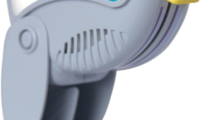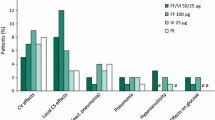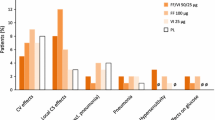Abstract
Current international guidelines for the treatment of asthma advocate inhaled corticosteroids as first-line therapy for persistent symptoms. As chlorofluorocarbon (CFC)-based products are being phased out because of environmental concerns, new inhaler propellants, such as hydrofluoroalkane (HFA)-134a, have been developed. The reformulation of existing corticosteroid compounds into HFA propellants has resulted in two distinct classes of corticosteroid aerosols consisting of HFA suspensions and HFA solutions.
The new HFA formulations of flunisolide and beclomethasone dipropionate exist as solutions, whereas HFA preparations of fluticasone propionate, triamcinolone acetonide, and mometasone furoate are formulated as suspensions. HFA suspensions retain the same particle size, deposition, and efficacy profiles as their CFC counterparts. HFA solutions, however, exist as extra-fine aerosols which have been shown to penetrate more effectively into the peripheral regions of the lung. Comparisons of HFA solutions with their CFC counterparts have demonstrated equivalent efficacy when given in smaller doses. The safety profiles of both HFA suspensions and solutions, given at equivalent doses, are comparable to CFC formulations.
Increasing evidence suggests that inflammation of the small airways plays an important role in the pathogenesis of asthma. Currently, the clinical implications of long-term treatment of the peripheral lung using an extra-fine inhaled corticosteroid aerosol remain uncertain. Future studies, involving histopathologic and clinical endpoints, will be necessary to determine whether treatment with HFA solutions offers significant advantages over currently available therapies.





Similar content being viewed by others
Notes
1 The use of brand names is for product identification purposes only and does not imply endorsement.
References
Borgstrom L. The pharmacokinetics of inhaled hydrofluoroalkane formulations. J Allergy Clin Immunol 1999; 104(6): S246–9
National Heart, Lung and Blood Institute. New NHLBI guidelines for the diagnosis and management of asthma. Lippincott Health Promot Lett 1997; 2(7): 1, 8–9
The Montreal Protocol on substances that deplete the ozone layer. Final Act (Nairobi: UNEP, 1987). Fed Reg 1994; 59: 56276–8
Dolovich M. Foreword. J Allergy Clin Immunol 1999; 104(6): 216
Seale JP, Harrison LI. Effect of changing the fine particle mass of inhaled beclomethasone dipropionate on intrapulmonary deposition and pharmacokinetics. Respir Med 1998; 92Suppl. A: 9–15
Leach CL. Improved delivery of inhaled steroids to the large and small airways. Respir Med 1998; 92Suppl. A: 3–8
Brindley A. The chlorofluorocarbon to hydrofluoroalkane transition: the effect on pressurized metered dose inhaler suspension stability. J Allergy Clin Immunol 1999; 104(6): S221–6
Gabrio BJ, Stein SW, Velasquez DJ. A new method to evaluate plume characteristics of hydrofluoroalkane and chlorofluorocarbon metered dose inhalers. Int J Pharm 1999; 186(1): 3–12
Bates DV, Fish BR, Hatch TF, et al. Deposition and retention models for internal dosimetry of the human respiratory tract: task group on lung dynamics. Health Phys 1966; 12(2): 173–207
Shaw RJ. Inhaled corticosteroids for adult asthma: impact of formulation and delivery device on relative pharmacokinetics, efficacy, and safety. Respir Med 1999; 9(3): 149–60
Richards J, Hirst P, Pitcairn G, et al. Deposition and pharmacokinetics of flunisolide delivered from pressurized inhalers containing non-CFC and CFC propellants. J Aerosol Med 2001; 14(2): 197–208
Cripps A, Riebe M, Schulze M, et al. Pharmaceutical transition to non-CFC pressurized metered dose inhalers. Respir Med 2000; 94Suppl. B: S3–9
Leach CL, Davidson PJ, Boudreau RJ. Improved airway targeting with the CFC-free HFA-beclomethasone metered-dose inhaler compared with CFC-beclomethasone. Eur Respir J 1998; 12: 1346–53
Leach CL, Davidson PJ, Boudreau RJ. HFA-beclomethasone dipropionate (BDP) provides equivelant lung deposition with or without add-on spacer [abstract]. Eur Respir J 1997; 10Suppl. 25: 236S
Pickering H, Pitcairn GR, Hirst PH, et al. Regional lung deposition of a technetium 99m-labeled formulation of mometasone furoate administered by hydrofluoroalkane 227 metered-dose inhaler. Clin Ther 2000; 22(12): 1483–93
Hirst PH, Pitcairn GR, Richards JC, et al. Deposition and pharmacokinetics of an HFA formulation of triamcinolone acetonide delivered by pressurized metered dose inhaler. J Aerosol Med 2001; 14(2): 155–65
Leach CL, Davidson PJ, Bredow TS, et al. Relative distribution of HFA-BDP within the lungs is unchanged regardless of patient degree of inhaler actuation coordination [abstract]. Am J Respir Crit Care Med 1999; 159: A116
Pritchard JN. The influence of lung deposition on clinical response. J Aerosol Med 2001; 14Suppl. 1: S19–26
Harrison LI, Soria I, Cline AC, et al. Pharmacokinetic differences between chlorofluorocarbon and chlorofluorocarbon-free metered dose inhalers of beclomethasone dipropionate in adult asthmatics. J Pharm Pharmacol 1999; 51(11): 1235–40
Soria I, Harrison LI, Mackacek JH, et al. Beclomethasone relative availability of oral versus inhaled beclomethasone dipropionate from an HFA-134A metered dose inhaler. Biopharm Drug Dispos 1998; 19(5): 297–302
Kunka R, Andrews S, Pimazzoini M, et al. Dose proportionality of fluticasone proionate from hydrofluoroalkane pressurized metered dose inhalers (pMDIs) and comparability with chlorofluorocarbon pMDIs. Respir Med 2000; 94Suppl. B: S10–6
Hampel F, Lisberg E, Guerin JC, et al. Effectiveness of low dose (50 and 100 microg b.i.d) of beclomethasone dipropionate delivered as a CFC-free extrafine aerosol in adults with mild to moderate asthma. J Asthma 2000; 37(5): 389–98
Matthys H, Nowak D, Hader S, et al. Efficacy of chlorofluorocarbon-free beclomethasone dipropionate 400 micrograms day-1 delivered as an extrafine aerosol in adults with moderate asthma. Respir Med 1998; 92Suppl. A: 17–22
Busse WW, Brazinsky S, Jacobsen K, et al. Efficacy response of inhaled beclomethasone dipropionate in asthma is proportional to dose and is improved by formulation with a new propellant. J Allergy Clin Immunol 1999; 104(6): 1215–22
Davies RJ, Stampone P, O’Connor BJ. Hydrofluoroalkane-134a beclomethasone dipropionate extrafine aerosol provides equivalent asthma control to chlorofluorocarbon beclomethasone dipropionate at approximately half the total daily dose. Respir Med 1998; 92Suppl. A: 23–31
Gross G, Thompson PJ, Chervinsky P, et al. Hydrofluoroalkane-134a beclomethasone dipropionate, 400 microg, is as effective as chlorofluorocarbon beclo- methasone dipropionate, 800 microg, for the treatment of moderate asthma. Chest 1999; 115(2): 343–51
Corren J, Nelson H, Greos LS, et al. Effective control of asthma with hydrofluoroalkane flunisolide delivered as an extrafine aerosol in asthma patients. Ann Allergy Asthma Immunol 2001; 87: 405–11
Tonnel AB, Bons A, Legendre M, et al. Clinical efficacy and safety of fluticasone propionate 250 microg twice daily administered via a HFA 134a pressurized metered dose inhaler to patients with mild to moderate asthma. Respir Med 2000; 94Suppl. B: S29–34
Perruchoud AP, Lundback B, Yigla M, et al. Clinical efficacy and safety of fluticasone propionate 1 mg per day administered via a HFA 134a pressurized metered dose inhaler to patients with moderate to severe asthma. International study group. Respir Med 2000; 94Suppl. B: S35–41
Ayres JG, Millar AB, Sykes AP. Clinical efficacy and safety of fluticasone propionate 1 mg twice daily administered via a HFA 134a pressurized metered dose inhaler to patients with severe asthma. U.K. study group. Respir Med 2000; 94Suppl. B: S42–50
Jacobson K, Chervinsky P, Noonan M, et al. Placebo-controlled, comparative study of the efficacy and safety of triamcinolone acetonide inhalation aerosol with the non-CFC propellant HFA-134a in patients with asthma: Azmacort HFA Clinical Study Group. Ann Allergy Asthma Immunol 1999; 83(4): 327–33
Welch M, Bernstein D, Gross G, et al. A controlled trial of chlorofluorocarbonfree triamcinolone acetonide inhalation aerosol in the treatment of adult patients with persistent asthma: Azmacort HFA Study Group. Chest 1999; 116(5): 1304–12
Fairfax AJ, Spelman R. 400 µg HFA-beclomethasone dipropionate extrafine aerosol (Qvar™) demonstrates equivalent improvement in ashtma control to 400 μg CFC-fluticasone propionate (Flixotide) [abstract]. Am J Respir Crit Care Med 1999; 159: A630
Thompson PJ, Davies RJ, Young WF, et al. Safety of hydrofluoroalkane-134a beclomethasone dipropionate extrafine aerosol. Respir Med 1998; 92Suppl. A: 33–9
Ayers JG, Simmons JL, Stampone P. Acute safety of beclomethasone dipropionate in a new CFC-free propellant system in asthmatic patients. Respir Med 1999; 93(1): 27–32
Casale TB, Nelson HS, Corren J, et al. Long-term safety of flunisolide hydrofluoroalkane metered-dose inhaler in adults and adolescents with asthma. Clin Drug Invest 2001; 21: 755–64
Woolcock AJ, Vincent NJ, Macklem PT. Frequency dependence of compliance as a test for obstruction in the small airways. J Clin Invest 1969; 48(6): 1097–106
McFadden Jr ER, Kiser R, DeGroot WJ. Acute bronchial asthma: relations between clinical and physiologic manifestations. N Engl J Med 1973; 288(5): 221–5
Wagner EM, Liu MC, Weinmann GG, et al. Peripheral lung resistance in normal and asthmatic subjects. Am Rev Respir Dis 1990; 141: 584–8
Saetta M, Di Stefano A, Rosina C, et al. Quantitative structural analysis of peripheral airways and arteries in sudden fatal asthma. Am Rev Respir Dis 1991; 143: 138–43
Kuwano K, Bosken CH, Pare PD, et al. Small airways dimensions in asthma and in chronic obstructive pulmonary disease. Am Rev Respir Dis 1993; 148: 1220–5
Kraft M, Djukanovic R, Wilson S, et al. Alveolar tissue inflammation in asthma. Am J Respir Crit Care Med 1996; 154: 1505–10
Goldin JG. Quantitative CT of the lung. Radiol Clin North Am 2002; 40(1): 145–62
Tashkin DP. HFA-BDP and its implications for the quiet zone. Respir Med 2000; 94Suppl. D: S37–9
Goldin JG, McNitt-Gray MF, Sorenson SM, et al. Airway hyperreactivity: assessment with helical thin-section CT. Radiology 1998; 208: 321–9
Paganin F, Trussard V, Seneterre E, et al. Chest radiography and high resolution computed tomography of the lungs in asthma. Am Rev Respir Dis 1992; 146: 1084–7
Newman KB, Lynch DA, Newman LS, et al. Quantitative computed tomography detects air trapping due to asthma. Chest 1994; 106: 105–9
Goldin JG, Tashkin DP, Kleerup EC, et al. Comparative effects of hydrofluoroalkane and chlorofluorocarbon beclomethasone dipropionate inhalation on small airways: assessment with functional helical thin-section computed tomography. J Allergy Clin Immunol 1999; 104: S258–67
Kharitonov SA, Barnes PJ. Clinical aspects of exhaled nitric oxide. Eur Respir J 2000; 16(4): 781–92
Tsoukias NM, George SC. A two-compartment model of pulmonary nitric oxide exchange dynamics. J Appl Physiol 1998; 85(2): 653–66
Silkoff PE, Sylvester JT, Zamel N, et al. Airway nitric oxide diffusion in asthma: role in pulmonary function and bronchial responsiveness. Am J Respir Crit Care Med 2000; 161: 1218–28
Pietropaoli AP, Perillo IB, Torres A, et al. Simultaneous measurement of nitric oxide production by conducting and alveolar airways of humans. J Appl Physiol 1999; 87: 1532–42
Marshall BG, Wangoo A, Harrison LI, et al. Tumour necrosis factor-alpha production in human alveolar macrophages: modulation by inhaled corticosteroid. Eur Respir J 2000; 15: 764–70
GINA guidelines [online]. Available from URL: http://www.GINASTHMA.org[Accessed 2003 Nov 20
Scottish Intercollegiate Guidelines Network [online]. Available from URL: http://www.sign.ac.uk/guidelines [Accessed 2003 Nov 20]
Acknowledgments
No sources of funding were used to assist in the preparation of this manuscript. Although Dr Corren conducts clinical trials for Forest Laboratories, the authors have no conflicts of interest that are directly relevant to the content of this manuscript.
Author information
Authors and Affiliations
Corresponding author
Rights and permissions
About this article
Cite this article
Zeidler, M., Corren, J. Hydrofluoroalkane Formulations of Inhaled Corticosteroids for the Treatment of Asthma. Treat Respir Med 3, 35–44 (2004). https://doi.org/10.2165/00151829-200403010-00005
Published:
Issue Date:
DOI: https://doi.org/10.2165/00151829-200403010-00005




